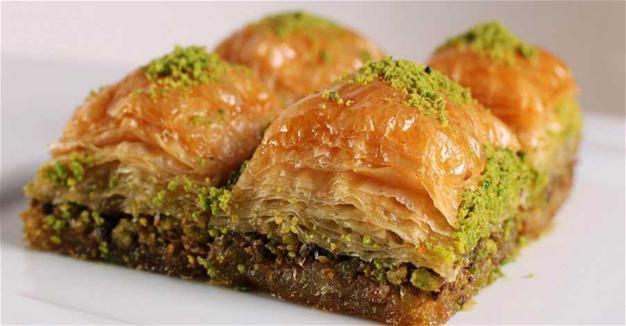Sticky Butterfly Wings
Aylin Öney Tan - aylinoneytan@yahoo.com
 “Our friends in the town keep us, as formerly, abundantly supplied with all the delicacies it affords: many of the dishes sent us are excellent; among others some butterfly-things of pastry, which one might blow away, but for the honey their wings are clogged with.”
“Our friends in the town keep us, as formerly, abundantly supplied with all the delicacies it affords: many of the dishes sent us are excellent; among others some butterfly-things of pastry, which one might blow away, but for the honey their wings are clogged with.” (James Stanislaus Bell, Journal of a Residence in Circassia during the years 1837, 1838 and 1839, London 1840, vol. 2 p. 417)
This must be one of the most hilarious descriptions of baklava ever. When served baklava in the town of Sinop, the British traveler James Stanislaus Bell felt like eating butterfly wings soaked in honey. Baklava must be one of the most controversial sweets of all times. Every nation over a wide region claims it as their own, and everyone has ideas on how an ideal baklava should be. It is hard to describe it to total strangers like Stanislaus Bell, who apparently had a hard time describing it himself when he first saw and tasted one.
When we look at history, we see many versions of baklava. Mary Işın, an expert on Ottoman confectionary and sweets, gives examples of its many kinds in her book “Sherbet & Spice”: “One of the earliest references to baklava is in a poem by the mystic Kaygusuz Abdal, who lived in the first half of the 15th century. Two hundred trays of baklava / Some with almonds some with lentils. Baklava filled with almonds is only to be expected, but lentils? The closest any other sources come to this is a 19th-century recipe for a baklava filling made with sweetened mashed beans. Perhaps lentils were the poor man’s substitute for almonds, or it may be a joke – like the anchovy-filled baklava Trabzon.”
As Işın notes, fillings for a baklava can be quite varied, as the options can be mind-blowing. Lentils and mashed beans could be health-freak versions in today’s world, but as Işın stated, lentils were probably a poor man’s choice, and beans must have been a novelty back in the 19th century; having just arrived from the new world, people just could not figure out what to do with it, while its chestnut-like, mealy and starchy consistency might have been deemed suitable for sweets. When one thinks of the Chinese moon cakes filled with red bean paste, this is not a far-fetched creation, but baklava in Turkey today is so associated with green pistachios that we can hardly imagine that other versions ever existed. Even the most common walnut filling seems to be a thing of the past, even though it was once the most common. Even in Gaziantep, the baklava and pistachio capital of Turkey, the elderly remember how three of four trays of baklava would be made with walnuts. But anchovies, as recalled by the 17th-century Ottoman traveler Evliya Çelebi, sounds like more of a joke, or maybe a flaky börek, made in the same fashion like a savory version of baklava.
Regional varieties of baklava usually contain nuts of all sorts as a filling; filberts, hazelnuts, almonds on a rare occasion, along with the more common walnuts and pistachios. One notable, but unfortunately long-forgotten filling was melon; an anonymous 18th-century recipe suggests the use of very sweet muskmelon flesh as a filling. Other fillings that seem to seen more rarely are the dairy fillings such as the expensive kaymak, the clotted cream, or cottage cheese. Afyon is one of the cities best known for the quality of its kaymak. Travelers’ tales from Afyon naturally have depictions of baklava with kaymak. Here again, we must refer to Işın’s book, where she gives an anecdote of Lady Agnes Ramsay when she was the guest of honor in the 1890s in the village of Şuhut near Afyon: “It was about 18 inches in diameter and the color of its crust was a gleaming golden brown. I will not attempt to describe the exquisite lightness of the flaky pastry or the delicate fragrance of the rich cream which filled it!”
Today, the cream filling is usually substituted by a mock cream one, prepared by cooking fine semolina with milk until it is a thick pudding ready to be smeared on to sheets of baklava as a filling. It is never sweetened, as the syrup will give the sweetness. Even pistachio and walnut baklavas usually have this coating of mock cream filling as a base for the nut layer. This again is an old practice stemming from recipes of old times; in an old recipe given in the book of Mehmed Kamil, dating back to 1844, suggestions for mock cream include mashed haricot beans, rice cooked in milk and fresh cottage cheese. These old variations give a hint to future chefs with ideas to play with, hopefully a few becoming classics.
Whatever the filling is, baklava with its flaky crisp pastry is a delight to enjoy for the Ramadan holiday, as delightful as watching a butterfly flying by, but yours might be stuck on your plate!
Fork of the Week
Using honey in baklava is also a thing of the past. All baklava is now made with syrup made with beet-sugar, with some baklava makers even choosing their sugar depending on its factory of origin. One must beware though of the ones using HFCS-high fructose corn syrup, usually marketed to producers as baklava syrup, ready to be diluted with water and boiled. I recently came across one baklava-maker who prefers to go old school and make baklava with honey. They use the honey from the eastern province of Erzincan, and have their own lab to check the purity and quality of the honey to be used. Rightly named Ballı Baklava (Baklava with Honey), they also make a grape molasses version, and also baklava with olive oil instead of the usual clarified butter. Orders can be made through https://www.ballibaklava.com.tr.
Cork of the Week
In the past, no Ramadan holiday was complete without a serving of assorted colorful sweet liqueurs along with coffee to follow the sweets. I remember finishing off leftovers from guests and licking the tiny shot glasses, eventually getting quite tipsy as a child at my grandmother’s house. Unfortunately, most of the wonderful liqueurs we used to have were discontinued when the state-monopoly Tekel was privatized. Still, there are some choices remaining in the market; check the Nazen or Hare brands, the only local brands that have some of the traditional tastes like the classic vişne (sour cherry), refreshing nane (mint), earthy bitter almond or the Turkish coffee variations. Another perfect drink to have with baklava is not tea or coffee, but milk. A little glass of cold milk really sooths down the excess sweetness in the mouth, and encourages one to take another wedge of that sticky butterfly wings!












